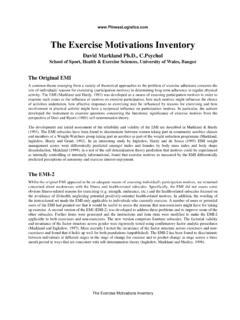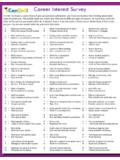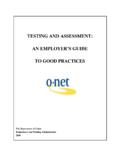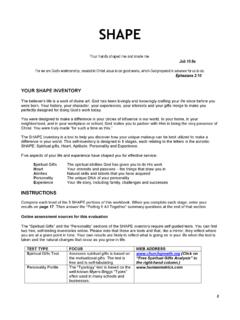Transcription of C H A P T E R Assets, Liabilities, and Net Worth 3
1 CHAPTER. Assets, liabilities , and Net Worth 3. OVERVIEW Progress Notes Assets, liabilities , and net Worth are part of the language of finance. As such, it is important to understand both After completing this chapter, their composition and how they fit together. Short defi- you should be able to nitions appear below, followed by examples. 1. Recognize typical assets. Assets 2. Recognize typical liabilities . Assets are economic resources that have expected future 3. Understand net Worth benefits to the business. In other words, assets are what terminology. the organization owns and/or controls. 4. See how assets, liabilities , liabilities and net Worth fit together.
2 liabilities are outsider claims consisting of economic obligations, or debts, payable to outsiders. Thus, liabili- ties are what the organization owes, and the outsiders to whom the debts are due are creditors of the business. Net Worth Insider claims are also known as owner's equity, or net Worth . These are claims held by the owners of the busi- ness. An owner has a claim to the entity's assets because he or she has invested in the business. No matter what term is used, the sum of these claims reflects what the business is Worth , net of liabilities thus net Worth .. The Three-Part Equation An accounting equation reflects a relationship among assets, liabilities , and net Worth as follows: assets equal 25.
3 26 Chapter 3 Assets, liabilities , and Net Worth liabilities plus net Worth . The three pieces must always balance among themselves because this is how they fit together. The equation is as follows: Assets 5 liabilities 1 Net Worth WHAT ARE EXAMPLES OF ASSETS? All of the following are typical business assets. Examples of Assets Cash, accounts receivable, notes receivable, and inventory are all assets. If the Great Lakes Home Health Agency (HHA) has cash in its bank account, that is an economic resource . an asset . The HHA is owed money for services rendered; these accounts receivable are also an economic resource an asset . If certain patients have signed a formal agreement to pay the HHA, then these notes receivable are likewise economic resources assets.
4 All types of business receivables are assets. The Great Lakes HHA also has an inventory of medical supplies (dressings, syringes, IV tubing, etc.) that are used in its day-to-day operations. This inventory on hand is an economic resource an asset . Land, buildings, and equipment are also assets. Exhibit 3 1 summarizes asset examples. Short-Term Versus Long-Term Assets Assets are often labeled either current or long-term assets. Current is another word for short-term. If an asset can be turned into cash within a 12-month period, it is cur- rent, or short term. If, on the other hand, an asset cannot be converted into cash within a 12-month period, it is considered long term.
5 In our Great Lakes HHA example, accounts receivable should be collected within 1 year and thus should be current assets. Likewise, the inventory should be converted to business use within 1 year; thus, it too is considered short term. Classification of the note receivable depends on the length of time that payment is promised. If the entire note receivable will be paid within 1 year, it is a short-term asset . Consider, however, what would happen if the note is to be paid over 3 years. A por- tion of the note that amount to be paid in Exhibit 3 1 asset Examples the coming 12 months will be classified as short-term, or current, and the rest of the Cash note that amount to be paid further in the Accounts receivable Notes receivable future will be classified as long-term.
6 Inventory The land, building, and equipment will Land generally be classified as long-term because Buildings these assets will not be converted into cash Equipment in the coming 12 months. Buildings and equipment are also generally stated at a net What Are the Different Forms of Net Worth ? 27. figure called book value, which reduces their historical cost by any accumulated deprecia- tion. (The concept of depreciation is discussed in Chapter 8.). WHAT ARE EXAMPLES OF liabilities ? All of the following are typical business liabilities . Examples of liabilities Accounts payable, payroll taxes due, notes payable, and mortgages payable are all liabilities .
7 The Great Lakes HHA owes vendors for medical supplies it has purchased. The amount owed to the vendors is recognized as accounts payable. When the HHA paid its employees, it withheld payroll taxes, as required by the government. The payroll taxes withheld are due to be paid to the government and thus are also a liability. The HHA has borrowed money and signed a formal agreement and thus the amount due is a liability. The HHA. also has a mortgage on its building. This mortgage is likewise a liability. In other words, debts are liabilities . Exhibit 3 2 summarizes liability examples. Short-Term Versus Long-Term liabilities liabilities are also usually labeled as either current (short-term) or long-term liabilities .
8 In this case, if a liability is expected to be paid within a 12-month period, it is current, or short-term. If, however, the liability cannot reasonably be expected to be paid within a 12-month period, it is considered long-term. In our Great Lakes HHA example, accounts payable and payroll taxes due should be paid within 1 year and thus should be labeled as current liabilities . Classification of the note payable depends on the length of time that payment is prom- ised. If the HHA is going to pay the entire note payable within 1 year, it is a short-term liability. But consider what would happen if the note is to be paid over 3 years. A por- tion of the note that amount to be paid in the coming 12 months will be classified as short-term, or current, and the rest of the note that amount to be paid further in the future will be classified as long-term.
9 The mortgage will be treated slightly differently. That portion to be paid within the coming 12 months will be classified as a short-term liability, while the remaining mortgage balance will be labeled as long-term. WHAT ARE THE DIFFERENT FORMS. OF NET Worth ? Exhibit 3 2 Liability Examples Net Worth the third part of the accounting Accounts payable equation is labeled differently, depend- Payroll taxes due ing on the type of organization. For-profit Notes payable organizations will have equity accounts with Mortgage payable which to report their net Worth . (Equity Bonds payable is the ownership right in property or the 28 Chapter 3 Assets, liabilities , and Net Worth money value of property.)
10 For example, a sole proprietorship or a partnership's net Worth may simply be labeled as Owners' Equity. A corporation, on the other hand, will generally report two types of equity accounts: Capital Stock and Retained Earnings. Capital stock represents the owners' investment in the company, indicated by their purchase of stock. Retained earnings, as the name implies, represents undistributed company income that has been left in the business. Not-for-profit organizations will generally use a different term such as Fund Balance Exhibit 3 3 Net Worth Terminology Examples to report the difference between assets and liabilities in their report. This is presumably For-profit sole proprietors or partnerships: because nonprofits should not, by defini- Owners' Equity tion, have equity.


















